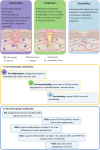Wound dressings: curbing inflammation in chronic wound healing
- PMID: 34196717
- PMCID: PMC8589427
- DOI: 10.1042/ETLS20200346
Wound dressings: curbing inflammation in chronic wound healing
Abstract
Chronic wounds represent an economic burden to healthcare systems worldwide and a societal burden to patients, deeply impacting their quality of life. The incidence of recalcitrant wounds has been steadily increasing since the population more susceptible, the elderly and diabetic, are rapidly growing. Chronic wounds are characterised by a delayed wound healing process that takes longer to heal under standard of care than acute (i.e. healthy) wounds. Two of the most common problems associated with chronic wounds are inflammation and infection, with the latter usually exacerbating the former. With this in mind, researchers and wound care companies have developed and marketed a wide variety of wound dressings presenting different compositions but all aimed at promoting healing. This makes it harder for physicians to choose the correct therapy, especially given a lack of public quantitative data to support the manufacturers' claims. This review aims at giving a brief introduction to the clinical need for chronic wound dressings, focusing on inflammation and evaluating how bio-derived and synthetic dressings may control excess inflammation and promote healing.
Keywords: chronic ulcers; collagen; inflammation; wound dressing; wound healing.
© 2021 The Author(s).
Conflict of interest statement
H.A.T. and A.F. are employees of 3M, and S.C. and D.V.V. received funding from 3M.
Figures
References
-
- Uluer, E.T., Vatansever, H.S. and Kurt, F.O˝. (2017) Wound healing and microenvironment. In Wound Healing (Turksen, K., ed.), pp. 67–77, John Wiley & Sons, Inc., Hoboken, NJ: 10.1002/9781119282518.ch5 - DOI
Publication types
MeSH terms
LinkOut - more resources
Full Text Sources
Other Literature Sources

